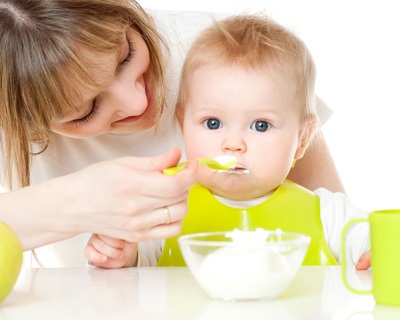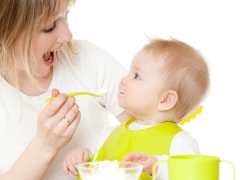When to introduce cottage cheese in prikorm child?
Cottage cheese is a delicious and extremely healthy dairy product, so you should definitely give it to your child. It is only important to find out at what age the introduction to the children's menu of cottage cheese and dishes from it is recommended, as well as how to acquaint the toddler with such a product correctly.
pros
- The baby will get calcium, vitamin A, folic acid, sodium, vitamin B12, phosphorus and other valuable ingredients from cottage cheese.
- Protein cottage cheese is represented by all the necessary amino acids for the body.
- Eating curds helps to strengthen the bone tissue of the baby.
Minuses
- Due to the early introduction of cottage cheese in the kid's menu, problems with digestion are possible.
- In industrial curds added fillers that can cause allergies.
- Cottage cheese is contraindicated in diseases of the kidneys, as well as intolerance to milk proteins.
- If the curd was stored in inappropriate conditions, it can cause food infections.
With intolerance to this product, a child develops a rash, diarrhea, restless behavior. The kid may complain of nausea, cramping abdominal pain.
From what age is it better to give?
For babies who were fed only breast milk before the introduction of complementary foods, most doctors recommend to try cottage cheese at 8-9 months. Crumbs, which received an adapted mixture, can be introduced to the curd a little earlier - from 6-7 months of age.
Earlier introduction of this product into the infant's diet is acceptable in case of rickets or severe weight gain.
Opinion E. Komarovsky
A popular doctor recommends starting to introduce cottage cheese at 6 months of age, adding it to kefir. Komarovsky explains the beginning of feeding with a fermented milk product by the fact that this product group is most related both to breast milk and milk formulas, so the baby will be better off digesting kefir and cottage cheese than the other food group foods.
Cottage cheese known pediatrician advises to add in the amount of one teaspoon from the fourth or fifth day from the beginning of the introduction to the children's menu of kefir. The best time for this dish, according to Komarovsky, is 9-11 am. If the reaction to the product is not marked, the next day the portion is doubled until the volume of cottage cheese is increased to 30-40 grams for a child from 6 to 8 months.

Enter into the diet
Most often, cottage cheese is introduced into the baby’s menu after the child has become accustomed to vegetables, cereals, and fruit foods. The first time this product is given to a healthy peanut in the morning. The first portion of cottage cheese should be a small amount of the product - from half to a whole teaspoon. Convinced of a good reaction to a new dish, the very next day its portion can be increased.
In what form can I give?
Starting acquaintance karapuz with cottage cheese should be with the use of the product in fresh form without any additives. Let the little one try out just cottage cheese, and perhaps the child’s taste will fully suit him.The child is best given freshly prepared curds, which stood in the open air up to two hours.
If the baby refuses unsweetened cottage cheese or you want to diversify cottage cheese complementary foods, add different types of fruit to this milk product. Dishes based on cottage cheese (casserole, dumplings, cheesecakes and others) are introduced into the toddler menu after 1.5 years.
How to choose a suitable cottage cheese?
Now on the shelves there is a fairly large selection of cottage cheese for baby food. This product is adapted to the needs of babies up to a year and is distinguished by a delicate taste and sour cream-like consistency.
Choosing such a curd, first of all it is worth taking a package, on which small periods of storage are marked. In this case, the product should be the most recent production date. It is desirable that in the purchased cottage cheese was not any additives. Cottage cheese, which is sold for adults, as well as curd bars with a variety of flavors can not be given to the crumbs.

Recipe for cooking at home
- Boil a liter of fresh milk, cool it to a temperature of about +35 degrees, then add 50 grams of starter, which can serve as sour cream, yogurt or kefir. When the milk is sour, place the dish with it in the water bath and keep on low heat for about 30-40 minutes. Having squeezed home cottage cheese, it is worth it to additionally beat with a blender.
- Another way of cooking a curd for a baby is curdling calcium chloride. Boiled and cooled milk (200-300 ml) mix with 2-3 ml of calcium chloride, then bring to a boil and discard on a sieve. The resulting cottage cheese grind blender.
- The third option to make cottage cheese is to heat the kefir. Pour it into a small saucepan, hold the container on medium heat. Kefir should heat up, but not boil. Soon you will notice that kefir is divided into a denser mass at the top and a thinner one at the bottom. Throwing the resulting product on the gauze, you remove the excess liquid and get the most delicate curds.



























































